Page 368 of 484
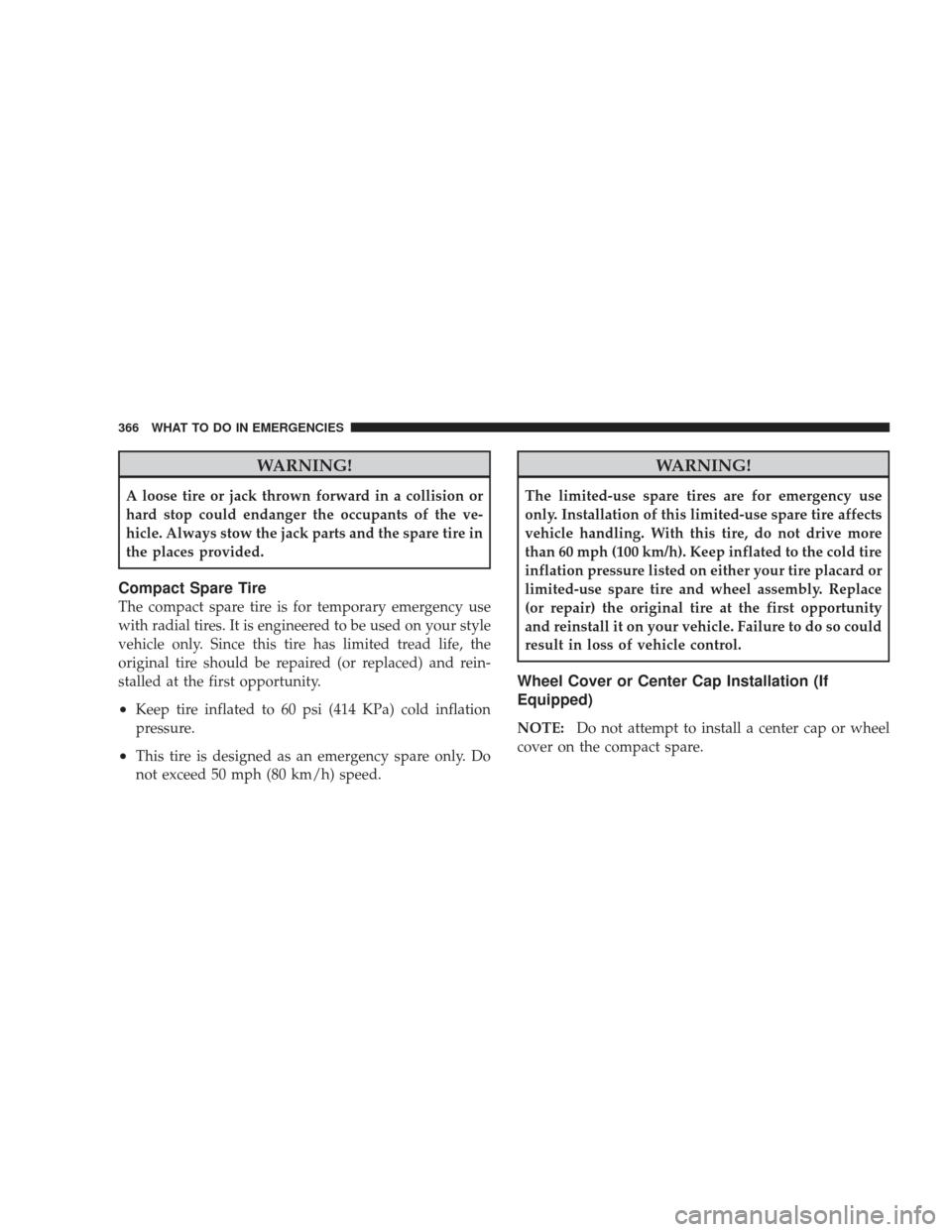
WARNING!
A loose tire or jack thrown forward in a collision or
hard stop could endanger the occupants of the ve-
hicle. Always stow the jack parts and the spare tire in
the places provided.
Compact Spare Tire
The compact spare tire is for temporary emergency use
with radial tires. It is engineered to be used on your style
vehicle only. Since this tire has limited tread life, the
original tire should be repaired (or replaced) and rein-
stalled at the first opportunity.
•Keep tire inflated to 60 psi (414 KPa) cold inflation
pressure.
•This tire is designed as an emergency spare only. Do
not exceed 50 mph (80 km/h) speed.
WARNING!
The limited-use spare tires are for emergency use
only. Installation of this limited-use spare tire affects
vehicle handling. With this tire, do not drive more
than 60 mph (100 km/h). Keep inflated to the cold tire
inflation pressure listed on either your tire placard or
limited-use spare tire and wheel assembly. Replace
(or repair) the original tire at the first opportunity
and reinstall it on your vehicle. Failure to do so could
result in loss of vehicle control.
Wheel Cover or Center Cap Installation (If
Equipped)
NOTE:Do not attempt to install a center cap or wheel
cover on the compact spare.
366 WHAT TO DO IN EMERGENCIES
Page 371 of 484
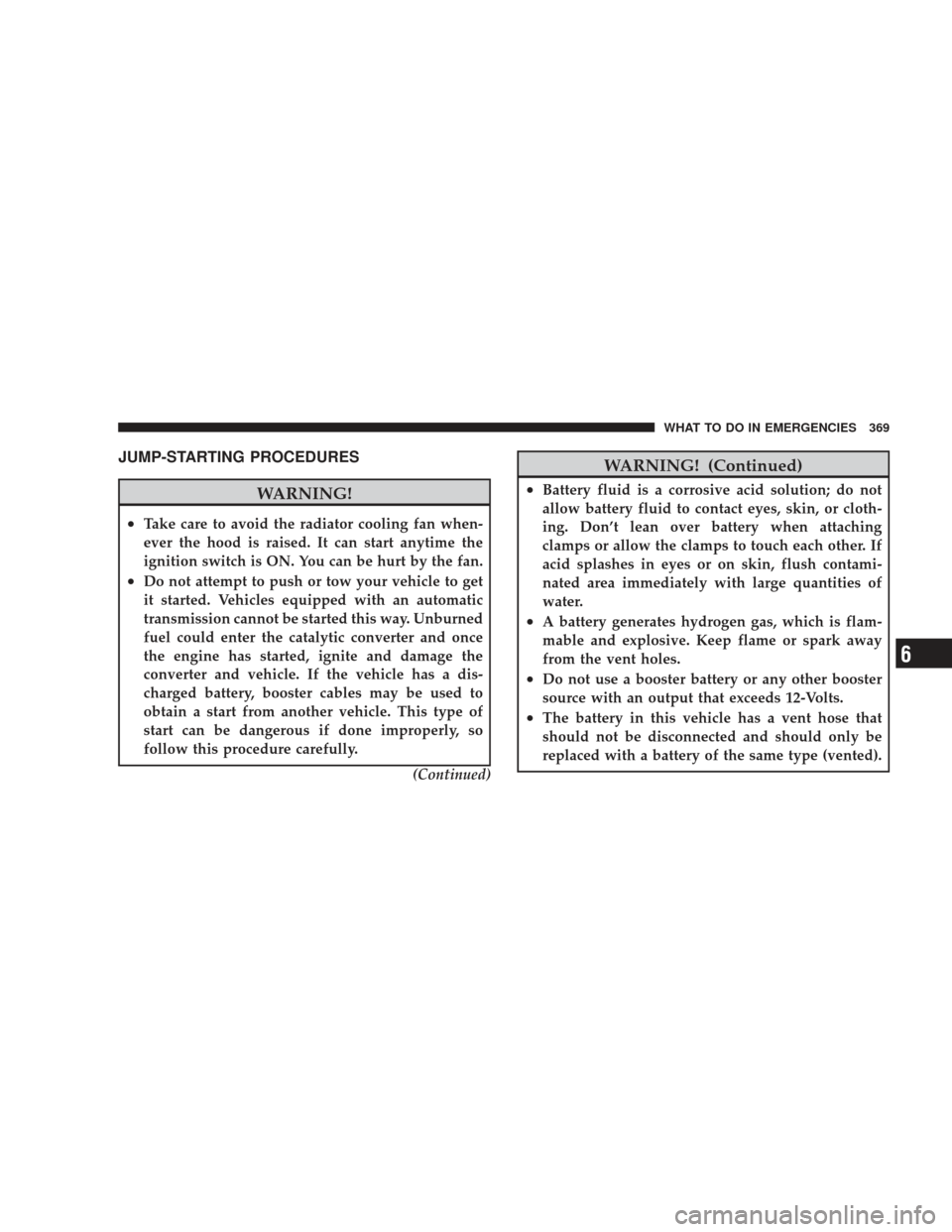
JUMP-STARTING PROCEDURES
WARNING!
•Take care to avoid the radiator cooling fan when-
ever the hood is raised. It can start anytime the
ignition switch is ON. You can be hurt by the fan.
•Do not attempt to push or tow your vehicle to get
it started. Vehicles equipped with an automatic
transmission cannot be started this way. Unburned
fuel could enter the catalytic converter and once
the engine has started, ignite and damage the
converter and vehicle. If the vehicle has a dis-
charged battery, booster cables may be used to
obtain a start from another vehicle. This type of
start can be dangerous if done improperly, so
follow this procedure carefully.(Continued)
WARNING! (Continued)
•Battery fluid is a corrosive acid solution; do not
allow battery fluid to contact eyes, skin, or cloth-
ing. Don’t lean over battery when attaching
clamps or allow the clamps to touch each other. If
acid splashes in eyes or on skin, flush contami-
nated area immediately with large quantities of
water.
•A battery generates hydrogen gas, which is flam-
mable and explosive. Keep flame or spark away
from the vent holes.
•Do not use a booster battery or any other booster
source with an output that exceeds 12-Volts.
•The battery in this vehicle has a vent hose that
should not be disconnected and should only be
replaced with a battery of the same type (vented).
WHAT TO DO IN EMERGENCIES 369
6
Page 372 of 484
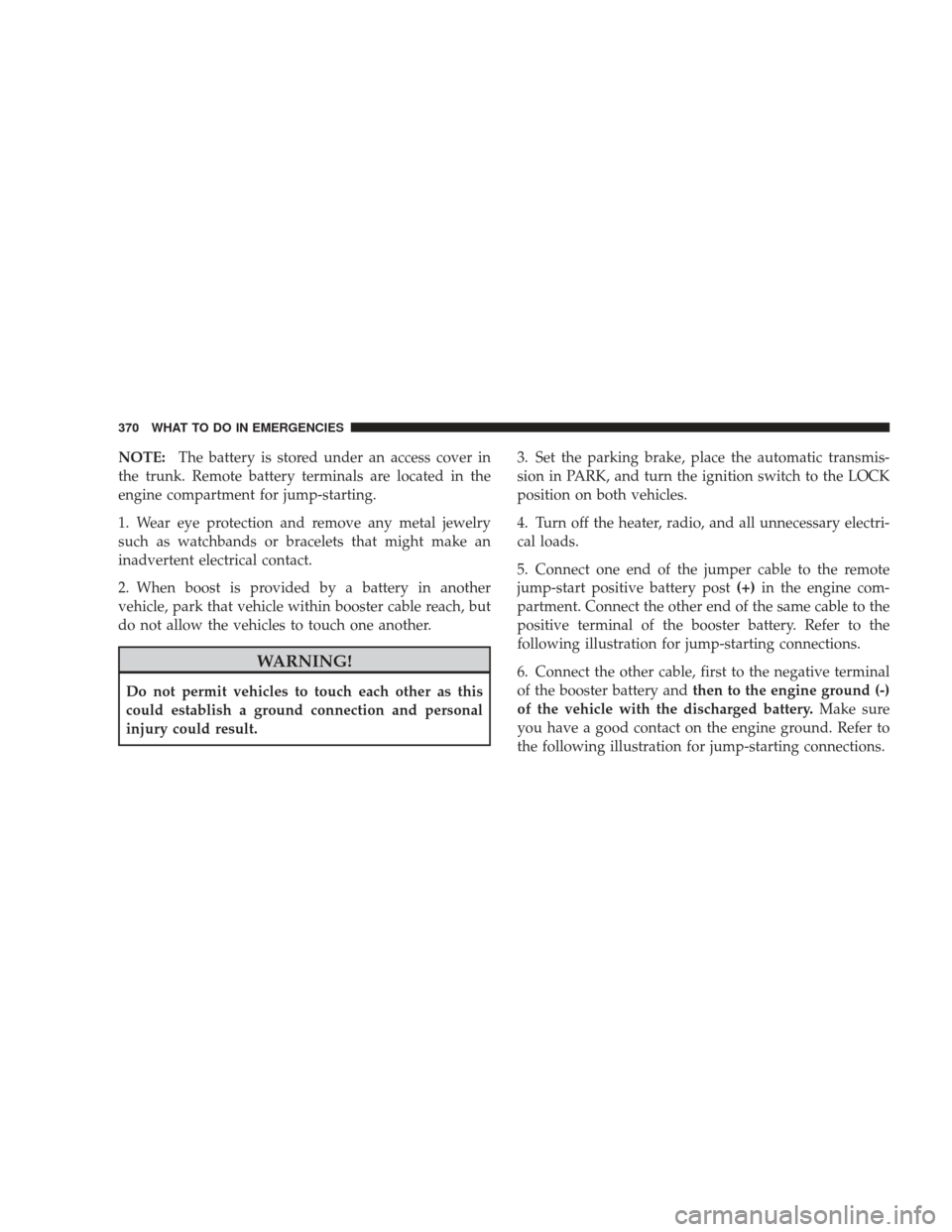
NOTE:The battery is stored under an access cover in
the trunk. Remote battery terminals are located in the
engine compartment for jump-starting.
1. Wear eye protection and remove any metal jewelry
such as watchbands or bracelets that might make an
inadvertent electrical contact.
2. When boost is provided by a battery in another
vehicle, park that vehicle within booster cable reach, but
do not allow the vehicles to touch one another.
WARNING!
Do not permit vehicles to touch each other as this
could establish a ground connection and personal
injury could result. 3. Set the parking brake, place the automatic transmis-
sion in PARK, and turn the ignition switch to the LOCK
position on both vehicles.
4. Turn off the heater, radio, and all unnecessary electri-
cal loads.
5. Connect one end of the jumper cable to the remote
jump-start positive battery post
(+)in the engine com-
partment. Connect the other end of the same cable to the
positive terminal of the booster battery. Refer to the
following illustration for jump-starting connections.
6. Connect the other cable, first to the negative terminal
of the booster battery and then to the engine ground (-)
of the vehicle with the discharged battery. Make sure
you have a good contact on the engine ground. Refer to
the following illustration for jump-starting connections.
370 WHAT TO DO IN EMERGENCIES
Page 373 of 484
WARNING!
•You should not try to start your vehicle by pushing
or towing.
•Do not connect the cable to the negative post of the
discharged battery. The resulting electrical spark
could cause the battery to explode.
•During cold weather when temperatures are be-
low the freezing point, electrolyte in a discharged
battery may freeze. Do not attempt jump-starting
because the battery could rupture or explode. The
battery temperature must be brought above the
freezing point before attempting jump-start.
7. Start the engine in the vehicle that has the booster
battery. Let the engine idle a few minutes then start the
engine in the vehicle with the discharged battery.
NOTE: Refer to�Synchronizing ESP� under�Electronic
Stability Program� in Section 5 if the ESP/BAS light (in
Jump-Starting
1 — Engine Ground
2 — Positive Battery Post WHAT TO DO IN EMERGENCIES 371
6
Page 374 of 484
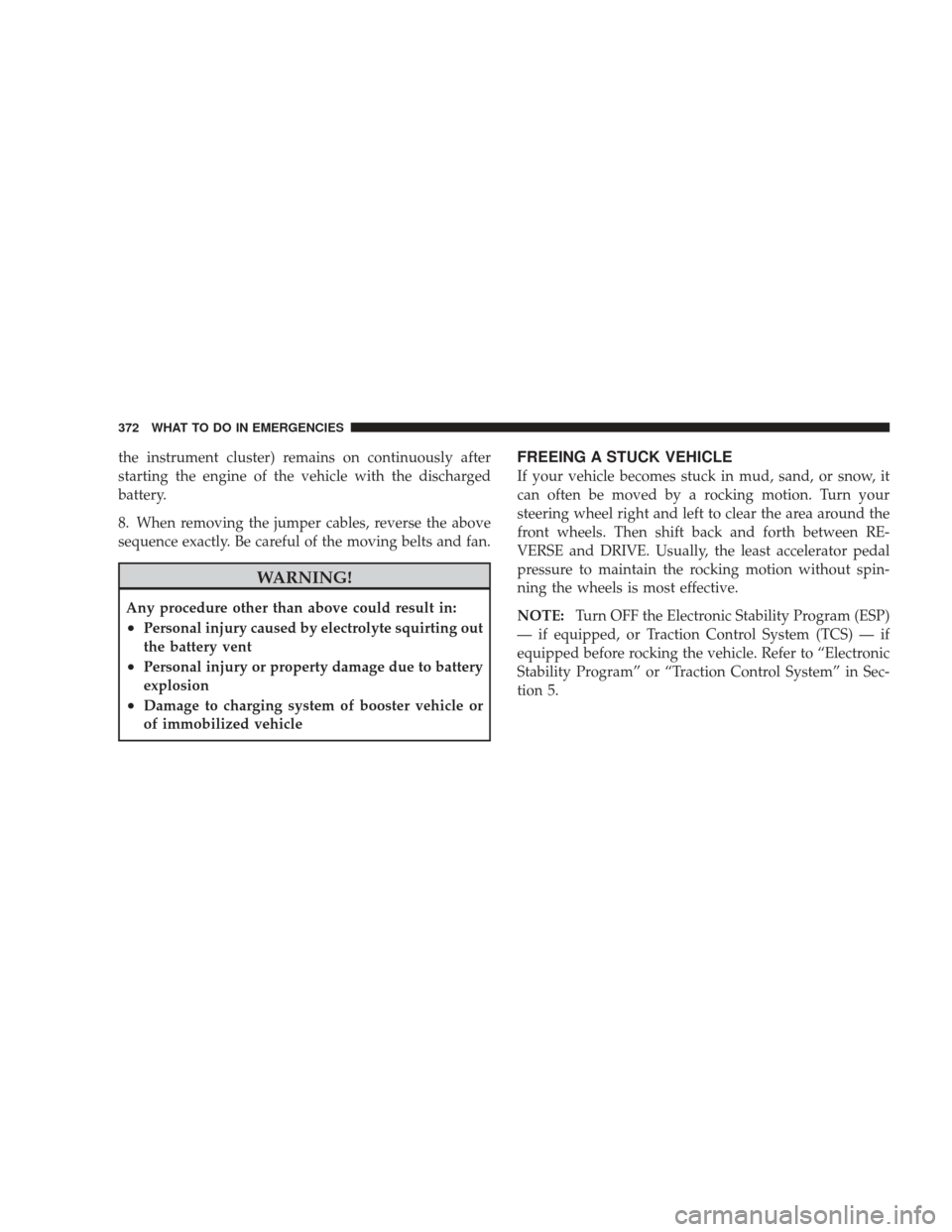
the instrument cluster) remains on continuously after
starting the engine of the vehicle with the discharged
battery.
8. When removing the jumper cables, reverse the above
sequence exactly. Be careful of the moving belts and fan.
WARNING!
Any procedure other than above could result in:
•Personal injury caused by electrolyte squirting out
the battery vent
•Personal injury or property damage due to battery
explosion
•Damage to charging system of booster vehicle or
of immobilized vehicle
FREEING A STUCK VEHICLE
If your vehicle becomes stuck in mud, sand, or snow, it
can often be moved by a rocking motion. Turn your
steering wheel right and left to clear the area around the
front wheels. Then shift back and forth between RE-
VERSE and DRIVE. Usually, the least accelerator pedal
pressure to maintain the rocking motion without spin-
ning the wheels is most effective.
NOTE:Turn OFF the Electronic Stability Program (ESP)
— if equipped, or Traction Control System (TCS) — if
equipped before rocking the vehicle. Refer to “Electronic
Stability Program” or “Traction Control System” in Sec-
tion 5.
372 WHAT TO DO IN EMERGENCIES
Page 375 of 484
CAUTION!
•When “rocking” a stuck vehicle by moving be-
tween 1st and REVERSE, do not spin the wheels
faster than 15 mph (24 km/h), or drivetrain damage
may result.
•Racing the engine or spinning the wheels too fast
may lead to transmission overheating and failure.
It can also damage the tires. Do not spin the
wheels above 35 mph (55 km/h).
WARNING!
Fast spinning tires can be dangerous. Forces gener-
ated by excessive wheel speeds may cause tire dam-
age or failure. A tire could explode and injure some-
one. Do not spin your vehicle’s wheels faster than
35 mph (55 km/h) when you are stuck, and don’t let
anyone near a spinning wheel, no matter what the
speed.
WHAT TO DO IN EMERGENCIES 373
6
Page 379 of 484
MAINTAINING YOUR VEHICLE
CONTENTS
�Engine Compartment — 2.7L ............. 379
� Engine Compartment — 3.5L ............. 380
� Engine Compartment — 5.7L ............. 381
� Onboard Diagnostic System — OBD II ...... 382
▫ Loose Fuel Filler Cap ................. 382
� Emissions Inspection And Maintenance
Programs ............................ 383
� Replacement Parts ..................... 384
� Dealer Service ........................ 385 �
Maintenance Procedures ................. 385
▫ Engine Oil ......................... 385
▫ Engine Oil Filter ..................... 388
▫ Engine Air Cleaner Filter ............... 389
▫ Maintenance-Free Battery .............. 389
▫ Air Conditioner Maintenance ............ 391
▫ A/C Air Filter ...................... 392
▫ Body Lubrication .................... 392
▫ Windshield Wiper Blades ............... 393
7
Page 380 of 484
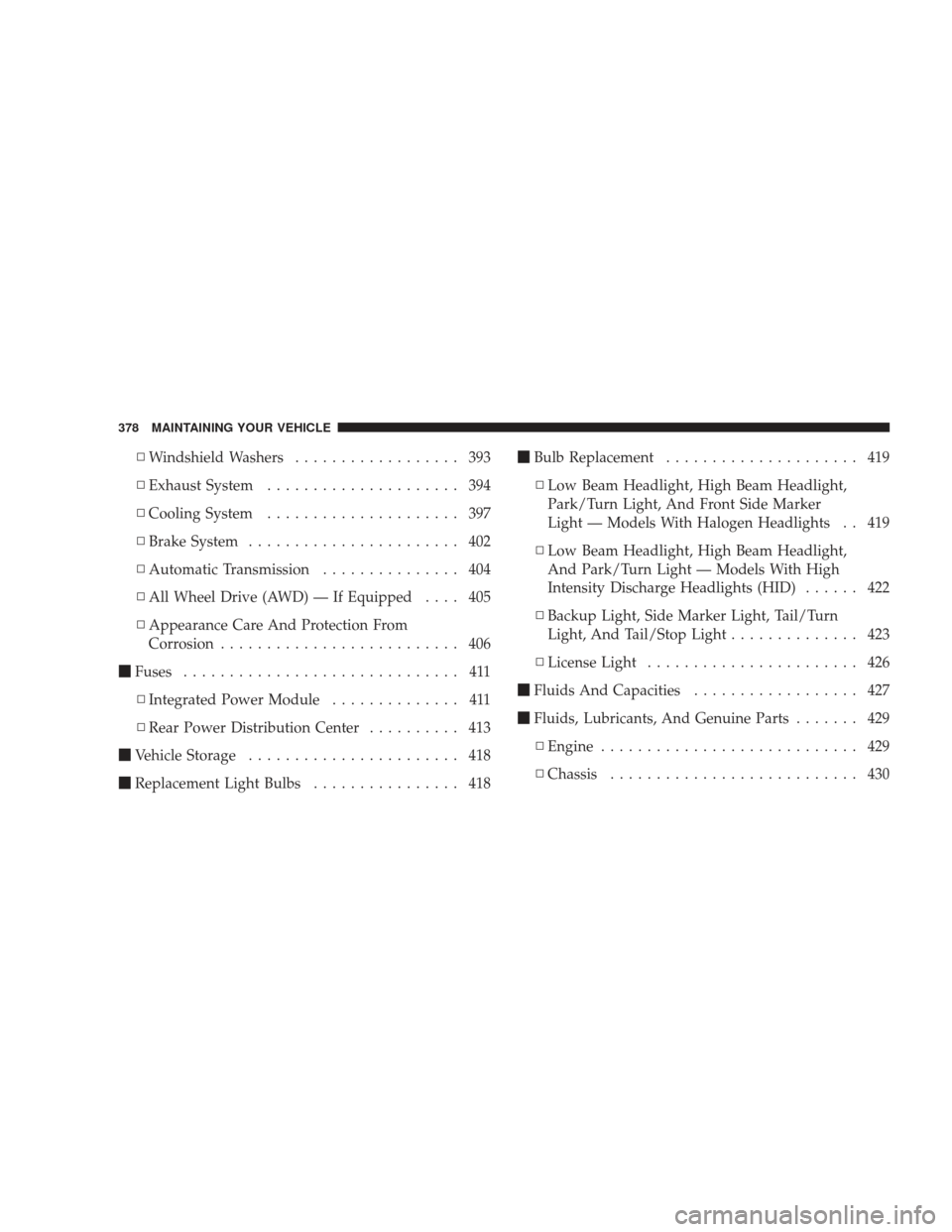
▫Windshield Washers .................. 393
▫ Exhaust System ..................... 394
▫ Cooling System ..................... 397
▫ Brake System ....................... 402
▫ Automatic Transmission ............... 404
▫ All Wheel Drive (AWD) — If Equipped .... 405
▫ Appearance Care And Protection From
Corrosion .......................... 406
� Fuses .............................. 411
▫ Integrated Power Module .............. 411
▫ Rear Power Distribution Center .......... 413
� Vehicle Storage ....................... 418
� Replacement Light Bulbs ................ 418 �
Bulb Replacement ..................... 419
▫ Low Beam Headlight, High Beam Headlight,
Park/Turn Light, And Front Side Marker
Light — Models With Halogen Headlights . . 419
▫ Low Beam Headlight, High Beam Headlight,
And Park/Turn Light — Models With High
Intensity Discharge Headlights (HID) ...... 422
▫ Backup Light, Side Marker Light, Tail/Turn
Light, And Tail/Stop Light .............. 423
▫ License Light ....................... 426
� Fluids And Capacities .................. 427
� Fluids, Lubricants, And Genuine Parts ....... 429
▫ Engine ............................ 429
▫ Chassis ........................... 430
378 MAINTAINING YOUR VEHICLE